As you may be aware, I’ve been working on a research project on tea the past few years. A paper just came out recently in the edited volume Moral Foods: The Construction of Nutrition and Health in Modern Asia, from the University of Hawaii Press. I have a chapter in there titled “Becoming Healthy: Changing Perception of Tea’s Effects on the Body.” It’s about how our idea of whether tea is healthy or not has shifted over time. Alas, I don’t have a PDF for you to read, but if you have access to a library that has (or will buy) this book, and find it interesting, do take a look.
Memorable places
November 9, 2019 · 6 Comments

Let’s face it, a Darjeeling teabag from Dammann Freres is never going to be that great, nor is it remotely worth the price of admission. I had some Dongding in my backpack that I would infinitely prefer to drink instead, but that would be rude. Their water wasn’t really hot enough anyway, and adding Taiwanese oolong to water (instead of pouring water over the leaves) is a loser’s bet. The overly aggressive pigeons trying to eat my apple pie were also not particularly welcomed, with me having to fend off their attacks while attempting this photo three times. I gave up trying to take a better one, lest I lose my pie to the indomitable birds.
I still thoroughly enjoyed my tea. The pie was good. The tea was serviceable. The view was excellent. The weather was almost perfect, if only it were a little bit warmer. I won’t remember this tea session for the tea itself, but it’s hard to beat St. Mark’s Square for location. The where and when of a tea session is often just as important as the what.
I’m in town for a colloquium on tea, which was organized by the Ca’Foscari University and the Confucius Institute here in Venice. As an academic with a research project in tea, it is rare to actually meet others similarly interested, more so as almost everyone was coming from a different disciplinary angle. Maybe I should’ve posted about this before the colloquium actually happened. But then, if you are from the area you might’ve already heard about it, and not rely on some long dormant blog to tell you. If you’re passing through like me, don’t waste your time in this gem of a city by spending a day listening to some academics talk about tea. Besides, the Italian Association of Tea Culture’s YouTube channel has posted the 2016 and 2017 renditions of their colloquiums for all to see. So maybe if you wait two years the 2019 one will be there too.
→ 6 CommentsCategories: Teas
Tagged: black tea, travel
Free tea
October 18, 2019 · 3 Comments
It’s been quiet around here. Like I’ve said before – I don’t have much that’s interesting to say these days, other than random snippets from my research. Drinking has been… pedestrian. Lots of teas that are just sort of daily drinkers, and nothing too special. Granted, I say this while sipping my 30+ years old baozhong as a daily drinker… but what’s there to say? It’s a bit sweet, a bit tart, tastes like old baozhong, and getting harder to find than ever.
However, recently I went back to my hometown and received a large amount of tea there as a gift. It was a nice gift, but it’s not tea that I drink – it’s green tea from Yushan, the local mountain in the city. It’s a green tea, although they call it Yushan white tea, supposedly because the teas are on the whitish side. I had some while I was there – it’s nice, sweet, and typical greens from the region.
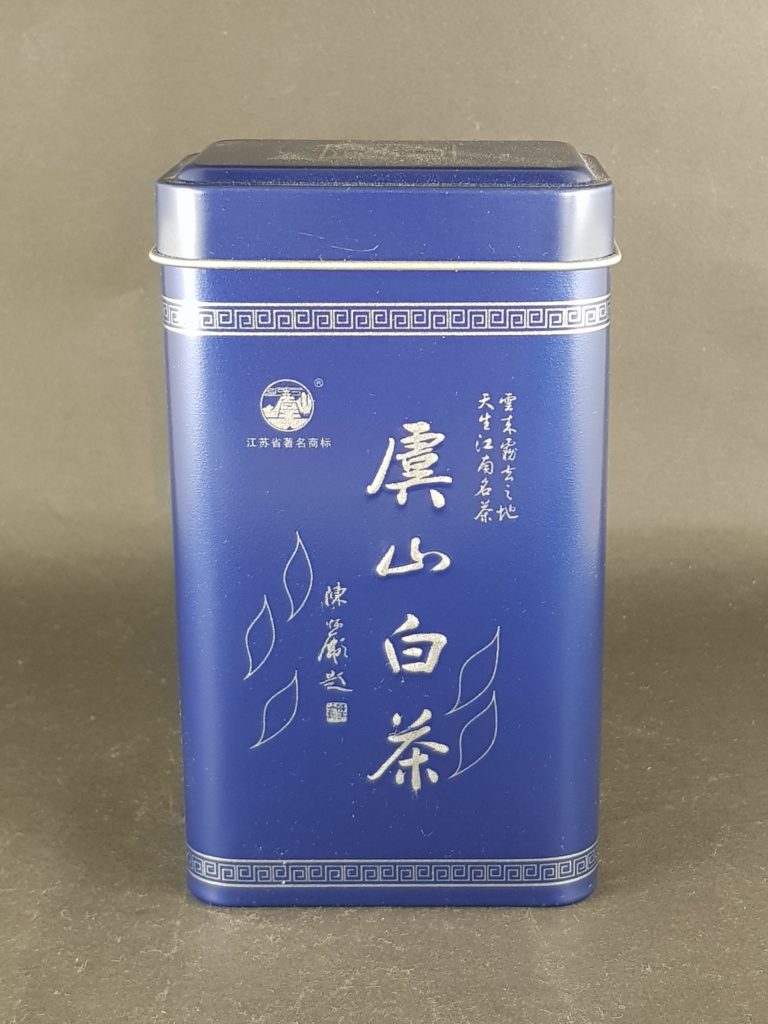
But, as I said, I got too much of it. I only need a can, maybe, for my own consumption needs. So here they are, I have 8 of these to give away. If you want one, email me at mail at marshaln.com. I’ll pay for shipping.
EDIT: Aaaaand they’re all gone. Thanks for the emails folks.
→ 3 CommentsCategories: Teas
Tagged: green tea, travel
A long walk away
May 3, 2019 · 5 Comments
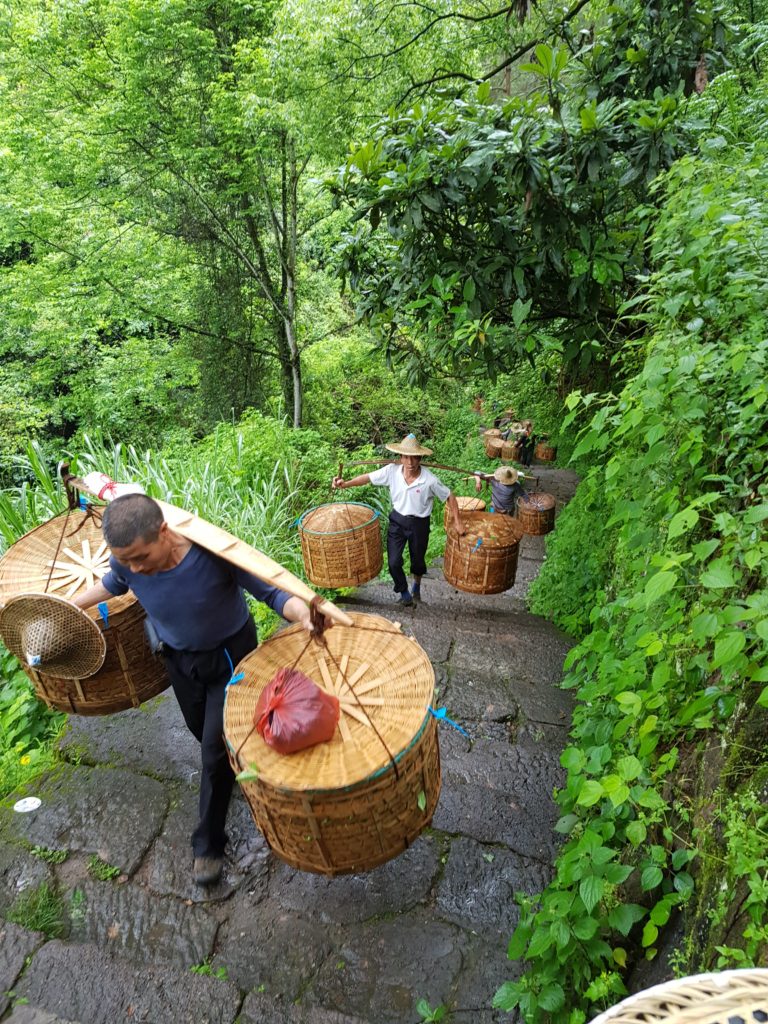
This shot is taken right where we got off our car as we entered the scenic park area – normal cars are not allowed to go in there now, you must take a bus. The only cars allowed in are tea producers’ with the right permit. These are guys whose job it is to haul the raw, freshly plucked leaves from the tea trees inside the scenic area to the waiting cars/trucks, and then hauling them to the factories for processing. Each of the load are 75-100kg. They’re heavy.
These are migrant labourers, mostly from neighbouring Jiangxi province, who get paid something like 200-300 RMB a day to do this work. Sure, the daily wage is fairly high, but it’s back breaking, and it’s only good for a few weeks of the year. For a good amount of the distance they have to travel, it’s on the paved walkway that you see – this was built in the 80s to accommodate tourists coming here. But then, at some point, you have to take a fork and up some dirt path along sometimes fairly steep hill, and then imagine coming back down from the hill with 100kg of tea on your back, in raining condition so that the paths are super slippery. This is not easy work at all.
The path was filled with people doing tea work that day. The teas in this area are all zhengyan, so they’re expensive and worth picking by hand. This means a lot of people are needed, and since everything is done by foot and the distance can be quite long, you need a lot of people very quickly to get things done. There are also some tourists who are just walking through the path, taking in the scenery.
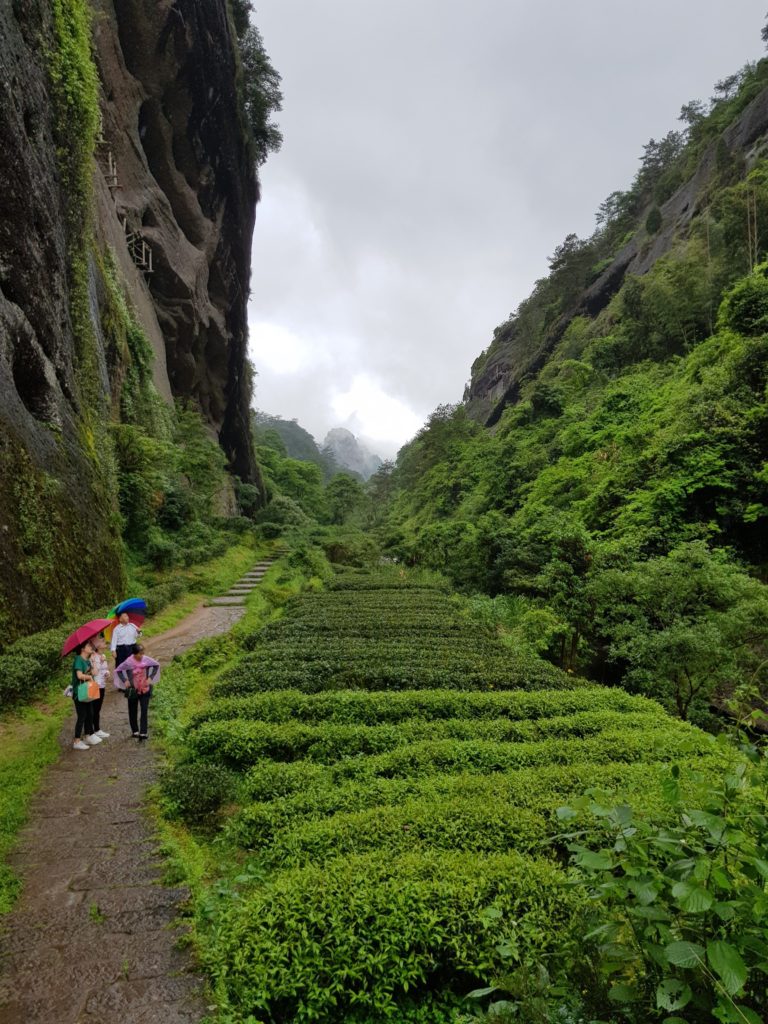
Tea trees are planted all along the path wherever there’s space. Until the 90s, there were a lot of villages inside this park area. People who planted (and still own) these tea trees were all villagers here. Back then, the primary processing areas – basically a shed and a few simple tools – were all very close to the tea planting area. Then the government moved all the villages out of the scenic area for protection of the area itself, because people pollute. So nowadays, the leaves have to be carried way out to get any processing done.
We took a path up a hill towards a plot of trees owned by a tea producer friend. When you walk into this narrow valley, it looks a bit like this
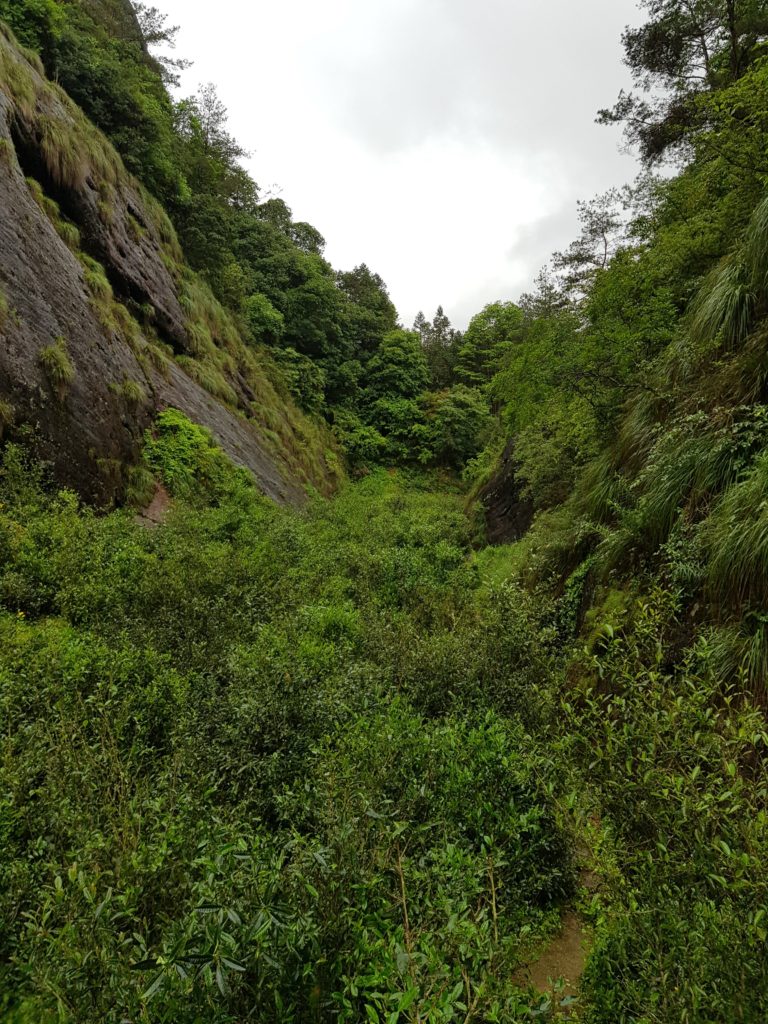
The valley is quite long and narrow, with steep hills on both sides. There’s only one way in and out. There’s a little stream of water flowing in the middle. It’s really ideal ground for tea plants – damp, cool, lots of shade, etc. It’s no wonder the tea here is good. Hiking up the hill to get here takes a bit of effort if you’re not in good shape, and I can’t imagine doing it with 100kg on my back. Many of the trees here are decades old. Prices, of course, match the quality.
One thing that surprised me is that they don’t really care if it’s raining – they’ll harvest anyway. If it’s very early in the season, and the rain is projected to stop very soon after, sometimes they’ll wait, but more often than not they’ll just harvest away – because there’s a lot of tea to harvest, and there just isn’t enough manpower and time to do it all at once. If you wait too long, the leaves get old and then it’s valueless. Since they only harvest once a year, that’s a lot of lost income if you let the leaves go. So, harvest they must, even if the processing is tougher and quality perhaps less than optimal.
We entered the park around 1:30, and didn’t leave till close to 6pm when the sun was setting. All the workers were finishing up as well, waiting for trucks to pick them up to go back, only to come back early the next morning to start again. Even then, I saw a couple workers taking photos of the scenery around them – even though it’s back breaking work, the natural beauty here is impressive and perhaps makes the work just a little more pleasant.
→ 5 CommentsCategories: Teas
Wuyishan
April 29, 2019 · 7 Comments

Last time I was here in Wuyishan was about twenty years ago. I had only just started drinking tea more seriously back then, and it was also a much calmer place than now. This time, I know a little more about tea, and the place is a lot busier – it’s like a giant tea mall now, with almost every single shop in town selling yancha of some kind.
On some level, most tea producing regions are the same in East Asia. They mostly work on a small farmer model, where individual farmer has a smallish holding of land with a limited production capacity. Calling them “plantation” would, for the most part, be a misnomer. These are family held farms, and most people here produce tea for their own sales.
This is, however, also a big tourist attraction because of its nature, so there are a fair number of stores in town that have nothing to do with any farm – their trade is the tourist one, and they’re here to make some money selling people tea. Well, everyone’s here to make money selling tea, but in these cases they’re traders. Nothing wrong with that, although, as per the Longjing rule, one ought to remember that just because someone’s in the production area, it doesn’t mean they’re here making tea or have direct access to teas.
I’m here to do research for my project. Thankfully, I have some contacts here through friends, and I’ve been to some tea farms and factories. Like I said, some things are about the same no matter what area you’re in. The Wuyishan area though has some unique properties.
The thing is, Wuyi tea is divided roughly into three areas – zhengyan (proper rock, literally), banyan (half rock), and zhoucha (island tea). The names don’t make a lot of sense in translation. Zhengyan means teas in the proper Wuyi areas – inside the valleys and hills of the Wuyi mountains national park area. Banyan are the stuff right around the area – like the photo above, basically on the outskirts of the national park. Then you have zhoucha, which is now a term generally meaning stuff all around even further away. Zhoucha is regional stuff made in the style of Wuyi teas, whereas zhengyan stuff is the “real deal”. Prices, of course, are according to these regions. Run of the mill zhengyan stuff will easily run over a couple thousand RMB for 500g, more of course if you’re buying from someone who sourced it and is selling to the Western market. Better stuff would be multiples of that.
Then there are these so called “special” areas – Niulan keng, Huiyuan keng, etc. There’s a lot of hype here, typical of the Chinese tea market these days. Prices can be sky high for some of these teas – like 20k USD a jin (500g) for some really special ones, even though these are sort of one of a kind trades. The more “regular” stuff can still run above ten thousand RMB a jin. It’s frankly pretty silly. Can the difference really be that great? Yes, I suppose, but in general, once you go above a certain price point… the incremental improvement in your experience is going to be marginal.
Then of course there are the fakes – cheaper stuff faking to be better ones, usually. Nobody would believe you if you sell a non Wuyi tea as a top grade one, but a banyan being sold as zhengyan? If you’ve never had a bunch of both, you probably can’t tell the difference. Banyan is still good tea, but you’ll pretty much never see people advertise it as that, unfortunately. As always, tea is pretty anonymous, and it’s quite easy to try to dress up a tea as something else.
It’s raining cats and dogs outside, and it’s 2:40am. Time for bed. Hopefully the rain stops and so I can go see some more teas tomorrow deeper into the park.
→ 7 CommentsCategories: Teas
Tagged: Chinese oolong, travel, wuyi yancha
2018 Shenzhen Global Tea Fair
December 24, 2018 · 2 Comments
I haven’t been to a mainland Chinese tea fair in quite a few years. Back in the day, I’d go when I get a chance, although in general, they’re all rather samey – a lot of big displays from big producers, plus a whole bunch of smaller stalls from smaller, no name sellers and producers that seem to exist on the sidelines just because. This year I got asked to give a talk at the 2018 Shenzhen Global Tea Fair, originally by Livio Zanini to be part of a panel. However, as that fell through, I figured… why not, I’ll go anyway, so I ended up going anyway to give a talk based on A Foreign Infusion.
One thing to note is that all these tea fairs around the country are done by the same company – Huajuchen, who have a rotating schedule of tea fairs all around. So there really is something to the idea that once you’ve been to one, you’ve been to all – because they’re all organized by the same people who travel around China to do these. Shenzhen is one of their biggest, and it’s big – about six halls worth of tea stalls. This is what parts of one looks like
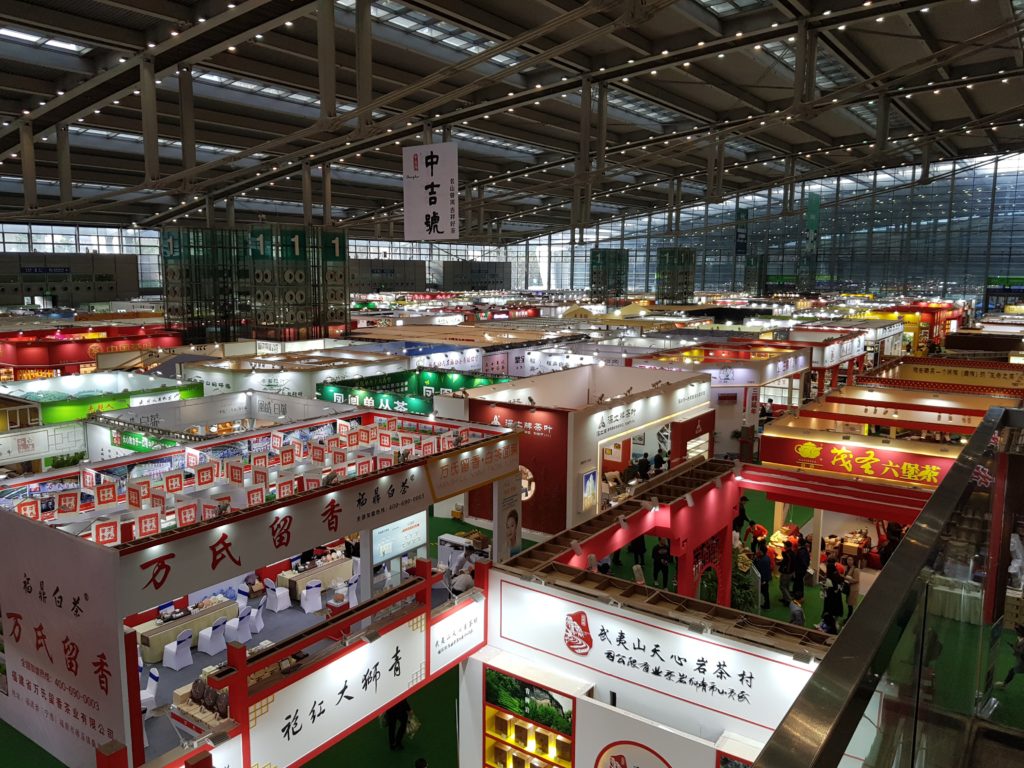
I got there early, before they formally opened, so I took a quick walk around before any customers showed up. Tea fairs in China are part trade show, part consumer expos. For the bigger producers, I think it’s a branding exercise. For the smaller guys, it’s an important retail outlet. Last time I went to a Chinese tea expo, probably ten years ago or so, it was mostly puerh. These days, there’s a lot more white tea and liubao, although puerh is still quite important. Interesting to note though, some of the biggest brands in pu, like Dayi, don’t seem to be there – perhaps there’s no real reason to splash a bunch of money on what has to be a lavish stall (because they’re the biggest brand after all) and the return on such a stall is minimal, since everyone already knows who they are.

For someone like me, the more interesting stalls are always the small ones. The big brands you can find everywhere, the small ones you never see. Unlike in the past, however, when I’d happily spend hours sitting at stalls drinking this year’s production, these days I’m really not very interested in new-make puerh. Instead, I looked around for older stuff – there isn’t much that is interested in the older puerh category, since they look kinda like this
Which are stalls that claim to sell “old tea, dry storage”, mostly pu from the 90s or 2000s, at pretty inflated prices and questionable quality. I can find cheaper or better elsewhere, no thanks.
There are also some interesting, new concepts like this one
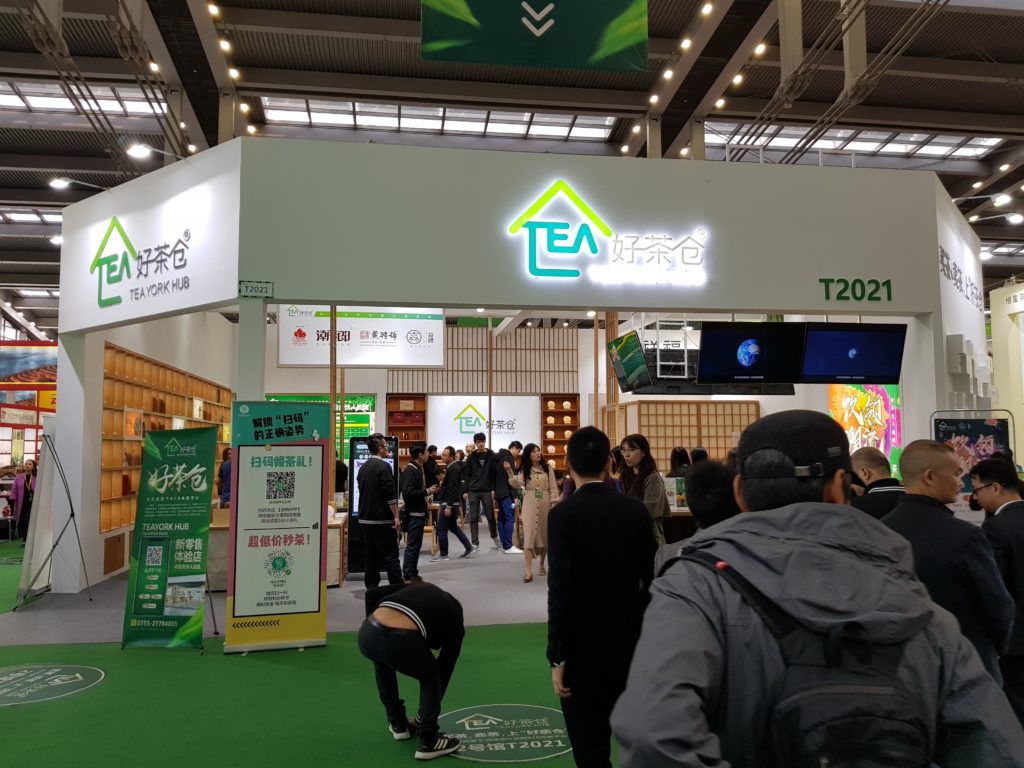
What the hell is “Tea York Hub” you ask? Well, the Chinese name makes more sense – “Haochacang” or “Good Tea Storage”. Basically, this is a rent-a-storage service. They’re not aiming to make money from selling you tea (although I think they dabble in that too) but they’re there to sell you tea lockers where you can store your tea in a climate controlled environment. Pretty brilliant, actually, capitalizing on people’s collections without taking on the risk of actually holding onto 1000 jians of Dayi 7542s. Dayi prices in recent days, for example, having been taking a bit of a dive.
After I gave my talk I ended up doing a few more rounds and ended up trying out some aged oolongs at a few stalls. Whereas I have a lifetime supply of old Taiwan oolongs, aged Wuyi, good ones anyway, are much harder to come by. I did end up at a guy who had some decent 15 years old aged Wuyi, and I bought a couple small cans. He’s one of these smaller producers with a store in Shenzhen. Maybe I’ll talk about the tea another day.
→ 2 CommentsCategories: Teas
Tagged: aged oolong, aged puerh, shopping, storage, travel
All quiet on the Hong Kong front
October 24, 2018 · 18 Comments
A few months ago, Tony, who used to run Origin Tea, messaged me this:
“You know, I was thinking the other day. You’ve already got more tea than you can drink in your lifetime, and most of it are teas you do like to drink(hopefully). You’ve already got a stupifying number of pots. There isn’t really much of an HK tea scene, and what there is, you know already. ….. so these days….. what more is there for you in tea? Periodic trips to Taiwan and |Japan keeping things refreshing?”
Well, he’s not wrong. My tea life these days is very simple – drink tea, usually in the office, and often the same kind of tea. There are a few go to favourites that I drink, but aside from that – not much else. I don’t buy new tea, generally speaking, because they’re both expensive and not that great. I drink stuff that are 10+ years old, usually. They sort of hit the right spot of reasonably priced and good tasting. I even bought some ten to twelve years old Dayi and they are very drinkable now. Don’t let anyone tell you 7542 is bad.
A consequence of this is the blog has suffered. I don’t have much new to say, and I don’t really want to repeat myself all that much. What I think is already mostly said somewhere on this blog. It might require some digging (and thus my request for crowd sourcing some kind of archive – I’ll get to work on it, and thank you all for your feedback). But if one is patient enough to go through the older posts, especially stuff that were posted after I moved here from Xanga, then you will find the blog to be about as informative as it’s ever going to be.
I suspect we all reach a point like this. Unless I’m posting endless reviews or some such, there is only so much to say.
→ 18 CommentsCategories: Teas
Tagged: musings
Not your average bottled tea
September 1, 2018 · 3 Comments
So, bottled teas are, of course, everywhere these days. Most of the time, they’re some cheap, crappy tea in a PET bottle. In a pinch, it’s good for a caffeine fix. That’s about it.
Not this one
I saw this at a local fancy supermarket. It’s in a wine bottle. It’s tea. You can read the description yourself. What I didn’t shoot was the price – one bottle of this “Queen of Blue Deluxe” is $800 HKD, roughly $100 USD, and you thought your $2.49 bottled green tea was expensive.
This company exists on the web. It’s Japanese, unsurprisingly. The tea “Queen of Blue Deluxe” also exists on their site, for about 4500 yen, which is like $40 USD. Quite a markup to sell at $100 instead, of course, but they do have to pay Hong Kong rent, shipping, etc.
Supposedly, the tea was extracted over the course of seven days in a kind of cold brew. Pro tip: you can probably do this at home in a fridge, for a lot less than $100 a bottle. If anyone wants to buy me one to try it, I’d be happy to give it a whirl. But at these prices, I’d rather buy this.
→ 3 CommentsCategories: Teas
Tagged: shopping, Taiwan oolong
Crowdsourcing an archive
July 12, 2018 · 13 Comments
So, one reason the blog isn’t nearly as active as before is because I don’t have a lot of new things to say. I feel like a lot of stuff that I need to say, I have already said (sometimes multiple times) somewhere on this blog.
However, the way this blog is currently organized is not very conducive to reading older posts. You can scroll chronologically, but that would include a lot of drivel with the more interesting posts. Some people have told me they have gone back and read everything, but even then, keeping track of stuff is hard. You can try the various tags I used, but I have kept those fairly general, so they’re not super useful (probably an understatement).
Thus I am writing here to ask for your help – if there’s something I’ve written in the past that you believe is interesting/useful/changed your ideas about tea, then I would love for you to tell me via a comment below (preferably with a link to the post itself). I’m going to try to collate them into an “archive” of sorts with individual links to posts on a separate page, so that people visiting this blog for the first time have somewhere to go to read the more interesting things. I see traffic statistics on posts, so I have some idea what are the ones people get linked to, but more traffic doesn’t mean better, especially since more clicks makes no difference for me given that there are no ads. So, tell me what you want to see in this “archive” of posts. I’ll try to keep it short-ish – maybe an upper limit of 20-30 posts in the past. We shall see, and thanks in advance for your suggestions.
→ 13 CommentsCategories: Misc
Tagged: administration, musings
Changing modes of production
May 27, 2018 · 3 Comments
Back in the day, farmers in Taiwan all produced their own tea – up to the point where the tea is dried and technically drinkable. The teas would then be sold to tea buyers whose job was to go to the villages and gather these teas. They would then sell the teas to wholesalers in places like Taipei, who would then blend, further process (mostly roasting), package, then sold either locally or, more likely, overseas.
Then, Taiwan’s economy changed, and with it the target market for their teas. While it was exporting to places like Japan, Taiwan was also consuming increasing amounts of their own tea. In fact, by the 1980s a majority of Taiwan’s teas were locally consumed, and now they’re actually quite significant importers of tea from other Asian countries, because the overall demand for tea is no longer satisfied by locally produced teas.
At the same time, things changed internally as well. For one, transportation is easier. Nowadays, for example, driving up to the tea mountains is just a weekend trip, whereas back then, going up takes real effort. If you have a car and you just want a weekend trip, well, the tea mountains are right there. Farmers started selling direct to consumers, instead of just to wholesalers. The old middleman stratum of traders no longer exist – wholesalers in big cities tend to buy direct from farmers, and farmers often sell to consumers directly as well, acting as retail as well as producer. Blending is no longer nearly as important as it used to be, replaced by individualized productions done by farmers or substitute processors – people who are paid by the kilo to do processing for other farmers. That tea you buy from farmer X directly is quite likely produced by processor Y (while farmer X works on his own competition tea, but that’s another topic).
Some consumers like this, because they feel like they’re buying direct from the farmer and so the tea is somehow more “authentic”. Even though often times these more entrepreneurial farmers who also retail tend to not only sell their own teas, but also teas of their friends – to provide enough variety for the consumer to buy from. Still, it’s an attractive model.
One of these guys that you might have encountered before is TeaHome, which has been active online for years now. You may have seen their oolongs on eBay, for example. I buy from them from time to time for very dependable teas – prices are reasonable and quality is decent. I’ve visited them before on a previous trip – the owner is an interesting guy with no background in tea prior to entering the business some 10+ years ago. He said he was a civil servant but due to one reason or another decided to become an organic tea farmer. He’s doing fairly well, as far as I can tell.
Another tea farmer I visited this trip that is also doing direct sales now has their own little brand called “Xin Cha Nong”, with an interesting url of teaez.com. Their family story is quite typical – two generations of tea farmers now. The dad (you can see his picture on the site) entered the tea business from farming other stuff because tea was far more profitable in the early 80s for farmers in the Dong Ding area – so like a lot of people he learned how to make tea and has been doing it ever since. The younger generation in the family is going to inherit the tea business, but are also branching out and are responsible for the sales/website part of the business. Learning how to do all that, while mastering these new skills, is part and parcel of how these tea farming families can stay alive.
Despite this though, there are a lot of upcoming problems that everyone is aware of. There is the typical East Asian problem of aging rural communities – young people generally don’t want to stay in the villages, and would prefer working in some higher prestige jobs in the cities instead. There are plenty of farmers with no one interested in taking over. Because of the downward pressure in prices for tea, lower elevation teas are becoming less lucrative, and many farmers have instead switched to farming other things – fruits, for example, which pay more and involve less work. There’s also labour issues – finding enough people to pick teas by hand is getting more and more difficult. These days almost all tea pickers during harvest season are foreigners from places like Vietnam and Burma. Give it another ten years, and many farmers have told me that they think they would have to figure out some way to make decent tea with machine harvest, because there will not be enough people to pick teas anymore. It’s a real crisis.
There’s no real telling how things will develop from here on out. Tea farms will surely still exist in Taiwan, as there are some young people willing to take up the mantle and others join in. The question is – what will that tea industry look like, and what kind of products are going to come out of it? That’s a much harder question to answer, and all we can do at this point is speculate.
→ 3 CommentsCategories: Teas
Tagged: Taiwan oolong, travel

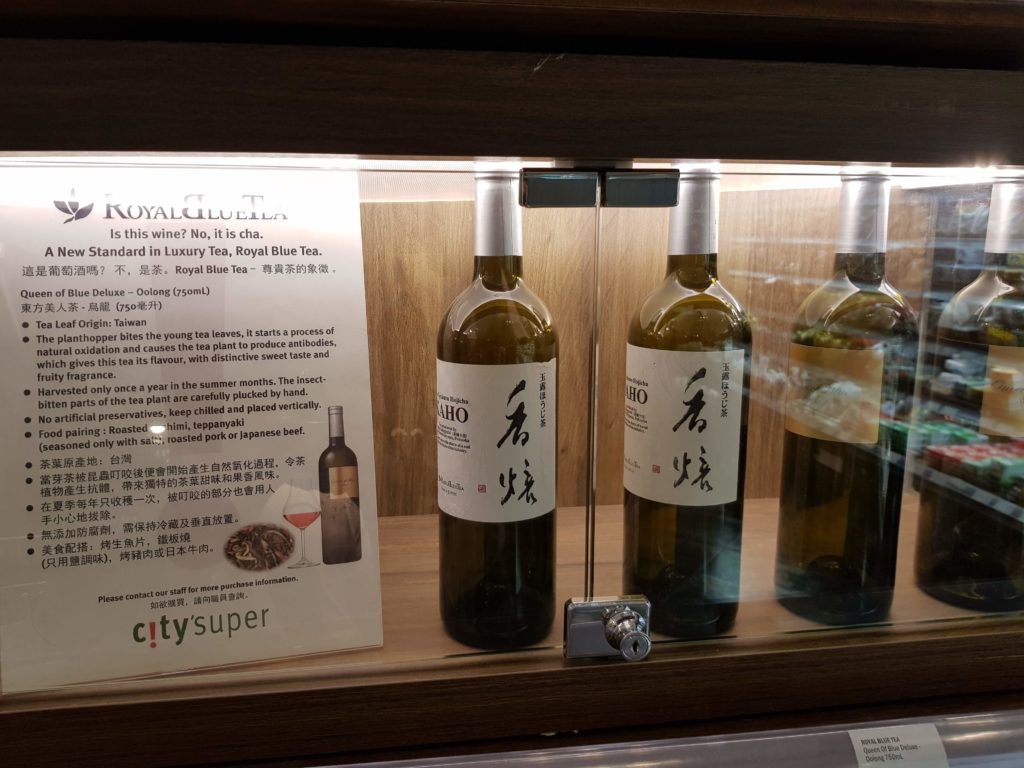
 RSS - Posts
RSS - Posts
Interesting.... would 250C in my oven work?